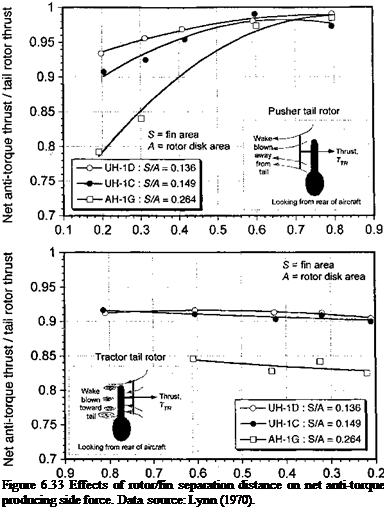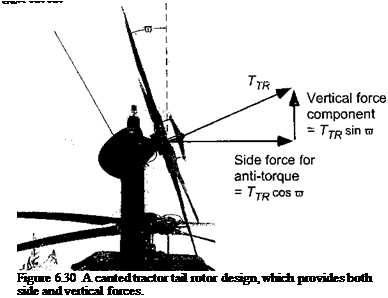Other High-Speed Concepts
Most of the major US helicopter manufacturers have undertaken studies of highspeed rotorcraft concepts. Similar studies have been conducted by some European manufacturers. The general requirements call for a rotorcraft capable of efficient hover capability that can cruise at over 400 kts, which is about twice as fast as is attainable with a conventional helicopter. Most concepts would be classified as convertible aircraft or convertiplanes. The primary advantage of any convertiplane concept is the ability to balance efficient hovering flight capabilities with efficient cruise and good range but without incurring large weight and cost penalties. Despite much research, there is no other high-speed or convertible rotorcraft concept currently flying other than tilt-rotors. Some of the high-speed rotorcraft designs considered have included the following:
1. The ABC concept: In the 1960s, Sikorsky Aircraft announced the XH-59A research aircraft using the Advancing Blade Concept (ABC). This was a compound concept with auxiliary propulsion and a rigid coaxial rotor system that was designed to alleviate the problem of retreating blade stall by allowing a more symmetric distribution of lateral airloads over the rotor disk. Chaney (1969) gives a good overview of the aerodynamic issues. During flight testing, the machine reached a maximum speed of 263 kts (487 kph). For the time, it was the only rotorcraft to have approached such speeds without lift compounding.
2. The X-wing concept: This design employs a unique rotor system that uses circulation control. The blades consist of thick elliptical airfoils, and air is blown at high velocity out of the leading or trailing edges to create lift by means of the Coanda effect – see Cheeseman (1968) and Williams (1976). A complicated pneumatic blowing system was required for cyclic blowing in forward flight. As airspeed built, the rotor system was designed to be slowed down and stopped, forming an X-wing configuration. The full-scale rotor was tested in a wind tunnel in the early 1980s, but it was never flown because of various technical issues and escalating costs.
3. The variable diameter rotor concept: This is another Sikorsky concept, which looks similar to a conventional helicopter but the blades telescope in length during flight to increase or decrease the disk area. The design is discussed by Fradenburgh et al. (1973) and Fradenburgh (1992). A system of clutches inside the rotor hub controls the extension and retraction process. This technique allows for low rotor disk loadings and maximum efficiency in hover, whereas the smaller diameter rotor allows for a higher cruise efficiency. A similar design has been considered for a tilt-rotor, where the rotor diameter is reduced for airplane mode – see Studebaker & Matuska (1993). The system has been successfully flown in the wind tunnel but not yet on a full-scale aircraft.
4. Rotor-wing concept: This is a high solidity stoppable rotor system with three blades. The rotor is slowed down and stopped in forward flight, with two blades pointing upstream forming forward swept wings, whereas the third blade points downstream and lies over the fuselage. The concept is similar to the ill-fated X – wing circulation-controlled rotor of the 1980s. See Rutherford et al. (1993) for a history of such stopped rotor designs.
5. Quad tilt-rotor: A quad tilt-rotor concept has been proposed in 1999 by Bell with a fuselage the approximate size of a large fixed-wing cargo airplane. Design features of the quad tilt-rotor include the use of two wings, one forward and one aft. Each wing has an engine and proprotor mounted at its tip. The civil version of the concept has been designed to carry up 100 passengers at 300 kts.
6. Folding, stowed, or trailed rotor systems: In this concept the rotor is stopped, the blades folded back into the fuselage, and the lift is transferred to fixed wings. Various aeroelastic effects are possible during the stopping and stowing process and these are difficult to contend with; see Celniker et al. (1965) and Deckert & McCloud (1968). The high capital and maintenance costs of the system, as well as the high weight of the folding and blade storage system, means that this type of machine is not a particularly attractive design option.
7. Shrouded rotor designs: The idea here is to use a relatively large ducted fan, integral to a wing, to provide the vertical lift. As the aircraft gains speed, power is transferred from the fan to pure propulsion, shutters cover the fan, and the wing provides all the lift. The concept, however, is not new, having being used on the Ryan XV-5 in the 1960s. This aircraft demonstrated successful transitions from hover to forward flight and back, flying at speeds of up to 330 kts (577 kph).
8. Slowed rotor concepts: By reducing rotor rpm in flight, this alleviates compressibility effects on the advancing blade and allows higher flight speeds. However, all rotor systems experience a loss of flapping rigidity with reduction in rotor rpm, so only about a 20-30% reduction in rpm seems possible before aeroelastic issues become critical. Nevertheless, some aerodynamic benefits at very high advance ratios seem possible, including better rotor lift-to-drag ratios. See also Celniker etal. (1965).
9. Gyroplane concepts: The gyroplane concept takes advantage of the vertical takeoff capabilities of the helicopter but the higher speed of a compound but with the rotor operating in the autorotative state. The ideas were explored in the 1950s by McDonnell with the XV-1 and by Fairey with the Gyrodyne and Rotodyne (see page 715). One advantage of a gyroplane is reduced capital and operating costs compared to a conventional shaft driven helicopter. It would appear that renewed interest in this concept may lead to its further development in the twenty-first century.
10. Morphing concepts: There have been many convertiplane concepts proposed over the years. More recently, the Mono Tilt-Rotor (MTR) has been proposed as an innovative convertiplane concept. Its capabilities are predicated on the combination of a single coaxial rotor system and sophisticated kinematics that morph the aircraft topology for efficient flight operations. As yet only developed in conceptual form [see Preator et al. (2004)], the MTR design fully integrates an efficient coaxial rotor, a folding lifting wing system and a cargo handling system that is capable of rapidly and economically moving different types of mission tailored payloads.











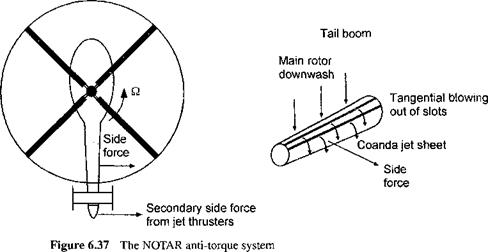
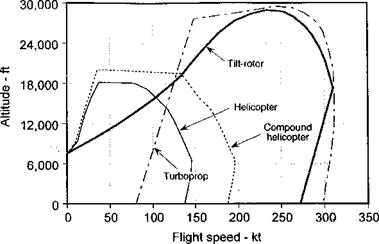
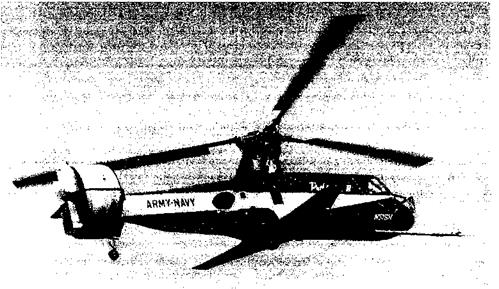


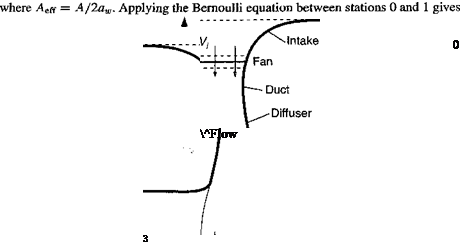
 (6.44)
(6.44) (6.45)
(6.45)
